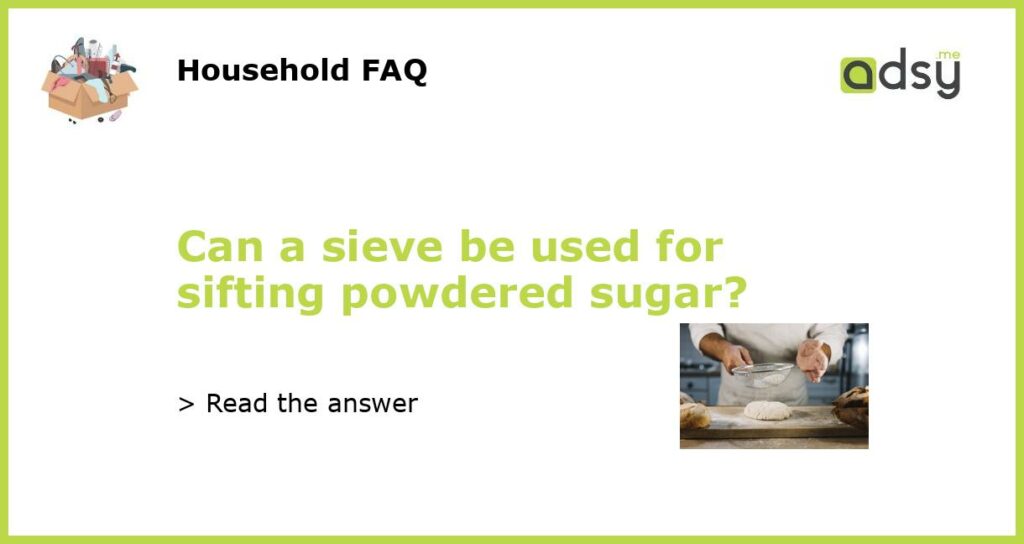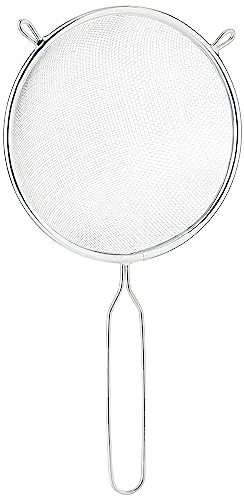Yes, a sieve can be used for sifting powdered sugar
When it comes to baking or creating delicious desserts, the texture and consistency of ingredients play a crucial role. Sifting powdered sugar is often required in various baking recipes, as it helps to remove any lumps or clumps and creates a smoother, finer texture. While there are specific tools designed specifically for sifting powdered sugar, a sieve can be a handy alternative that most people already have in their kitchens.
What is a sieve?
A sieve, also known as a sifter or a strainer, is a kitchen tool used for separating and removing unwanted solids from dry ingredients. It consists of a mesh screen stretched over a circular or square frame, allowing finer particles to pass through while retaining larger particles. Sieves are commonly used in cooking and baking to remove lumps or impurities from flour, cocoa powder, and powdered sugar.
How to use a sieve for sifting powdered sugar
Sifting powdered sugar with a sieve is a simple process that can be done in a few easy steps:
- Choose a fine-mesh sieve: To ensure a smooth and even sifting process, choose a sieve with a fine mesh. This will help remove any lumps more effectively.
- Prepare the powdered sugar: Before sifting, make sure the powdered sugar is free of any clumps. If necessary, break up the clumps using a spoon or a fork.
- Position the sieve: Place the sieve over a clean bowl or a piece of parchment paper. Make sure the bowl or paper is large enough to catch all the sifted sugar.
- Add the powdered sugar: Pour the powdered sugar into the sieve, filling it up to about three-quarters full. If the sieve is too full, the sugar may not sift evenly.
- Sift the sugar: Holding the sieve over the bowl or parchment paper, gently tap or shake it to sift the powdered sugar through the mesh. Slowly move the sieve in a circular or back-and-forth motion to ensure even distribution.
Repeat the process if necessary: If there are still lumps or clumps remaining in the sieve after the first sift, empty the sieve and repeat the process until the powdered sugar is smooth and lump-free.
Why use a sieve for sifting powdered sugar?
Sifting powdered sugar is essential in baking for several reasons:
- Removing lumps: Powdered sugar can develop lumps over time due to moisture exposure or improper storage. Sifting helps break up these lumps and ensures a smoother consistency in the final product.
- Creating a lighter texture: Sifting powdered sugar helps incorporate air into the sugar, resulting in a lighter texture. This is particularly important in recipes like frosting or meringue, where a smoother and fluffier consistency is desired.
- Even distribution: Sifting helps evenly distribute powdered sugar in the recipe, ensuring that all the ingredients are thoroughly mixed. This promotes consistent flavor and texture throughout the baked goods.
Alternatives to using a sieve
If you don’t have a sieve on hand, there are a few alternatives you can use for sifting powdered sugar:
- Whisk: A whisk can be used to break up lumps and incorporate air into the powdered sugar. Simply whisk the sugar vigorously in a bowl until smooth.
- Fork: Similar to a whisk, a fork can be used to break up lumps and sift powdered sugar. Gently press the fork against the lumps to break them up, then use a circular motion to sift the sugar through the tines.
- Fine-mesh strainer: If you have a fine-mesh strainer or a colander with small holes, you can use it in place of a sieve. Follow the same steps as using a sieve, pouring the powdered sugar into the strainer and gently shaking or tapping it to sift the sugar through.
While a sieve is the most commonly used tool for sifting powdered sugar, these alternatives can be effective in a pinch. However, it’s important to note that the results may not be as fine or consistent as when using a sieve.






